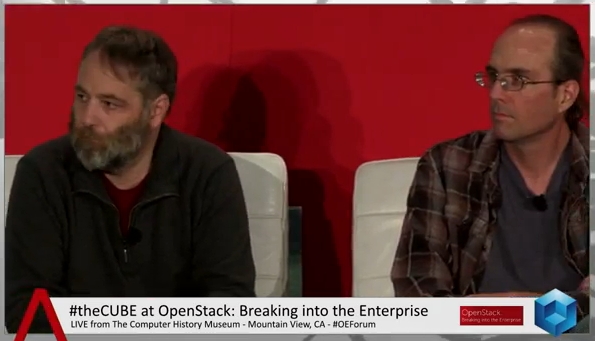 NEWS
NEWS
 NEWS
NEWS
 NEWS
NEWS
![]() The OpenStack and Enterprise Forum, recently concluded at the end of January 29, at the Computer History Museum in Mountain View, California, was moderated by Lydia Leong, Research Vice President with Gartner.
The OpenStack and Enterprise Forum, recently concluded at the end of January 29, at the Computer History Museum in Mountain View, California, was moderated by Lydia Leong, Research Vice President with Gartner.
Panel 2 of “OpenStack: Breaking into the enterprise” brought together Raj Dutt, Senior Vice President of Technology with OpenStack, JC Martin, the Chief Architect of Global Cloud Services at eBay Inc., Rodney Peck, the Architect for Storage at PayPal and Surendra Reddy, CTO with PARC, a Xerox Company.
After a chat with Raj Dutt debating the advantages within the OpenStack Enterprise (read more about it here), Leong let Martin and Peck detail their own experience with OpenStack.
“In 2008 we started developing our own private cloud, and the main driver was agility. At the time there was no project like OpenStack so we had to do our own, and when OpenStack started to mature we looked at our options and we started adoption of open source cloud to replace our in-house, custom cloud management system, because it gave us more advantages compared to proprietary in-house solutions.”
According to Martin, OpenStack is used in three main types of projects:
1) developer projects
2) Q.A. / analytics
3) production
The teams at eBay Inc. and PayPal are now merged together, with eBay doing the OpenStack deployment.
“What made you decide to use OpenStack?” asked Leong. “What else have you considered using?”
“Two, three years ago we tried to find partners to develop our cloud, we talked to many software vendors and we looked at cloud.com before they were acquired by Citrix,” Martin started. “The main reason we selected OpenStack was the architecture which was very distributed. The language is also a plus, because we can find developers more easily than Java. People in the community are more attracted by languages like Python. Also, the size of the community was an important factor. For us, the main decision point was ‘who was going to win at the end’, and that was indicated by the size of the community and the ecosystem, so we started to build around OpenStack,” explained Martin.
Following Martin’s intro, Peck clarified that he was brought in “specifically as an OpenStack developer, because they had already chosen OpenStack.”
Leong next asked, “what was the initial experience of deploying OpenStack: challenges, what went well, and so on…”
“At first everything is nice and friendly, and then you get to a certain size and you get a lot of issues,” began Peck. “We had to find solutions for these issues and then try to work with the community to find out if our solutions were the best, or if they were going to be supported in the future. In that sense, we tried staying close to the community, leveraging that and not going with the vendors’ solution completely.”
This allowed them to skip vendor distribution all together.
“What were some of the challenges you encountered?” inquired Leong.
“As it was mentioned earlier, a lot of the vendors say they inter-operate, but really they don’t. When things go big, they tend to burst at the seams,” joked Peck.
“You are running a solution at scale, how big is your solution today?” asked Leong.
“Multiple thousand hypervizors, more or less distributed across multiple data centers,” replied Martin.
“How much operation does it take to keep this OpenStack cloud running happily?”
“If you are just talking about the operation of the OpenStack components… One of my colleagues did a presentation at the last Summit clarifying that OpenStack is not cloud, OpenStack is just the automation system, the framework that allows you to operate the cloud. There’s many other things that go around OpenStack, like monitoring, all your processes, capacity management, fulfillment, etc. For us this is something that we used to do before, because we were running our cloud. We have a system for on-boarding full racks of compute servers, automatically, and converting that into OpenStack compute.
“For us this was not a gap, it was a quick add-capacity,” clarified Martin. “But for others without those capabilities it would require more effort, so the answer is ‘it depends on your existing capabilities.’ If you’re starting from scratch, it can be a little overwhelming,” warned Martin.
“What was the most effective way to engage the (OpenStack) community?” asked Leong.
“We attend various summits, we try to foster new projects and to participate in existing projects, following-up and contributing back to the community,” said Martin.
You can watch JC Martin and Rodney Peck below:
The last guest on the Panel was Surendra Reddy, CTO with PARC, a Xerox Company, who spoke about the role of OpenStack in his own organization. Read more about his input here.
THANK YOU